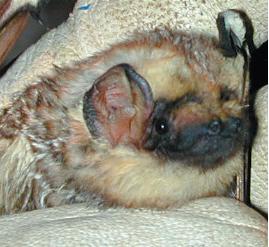Hoary bat: Difference between revisions
Mindmatrix (talk | contribs) add Category:Bats of Canada; formatting: 2x whitespace (using Advisor.js) |
|||
| Line 1: | Line 1: | ||
{{Taxobox |
{{Taxobox |
||
| name = Hoary bat |
| name = Hoary bat |
||
| status = lc |
| status = lc |
||
| status_system = iucn3.1 |
| status_system = iucn3.1 |
||
| status_ref = <ref name=iucn>{{IUCN2009.2|assessors=Gonzalez, E., Barquez, R. & Arroyo-Cabrales, J.|year=2008|id= 11345|title=Lasiurus cinereus|downloaded=07 February 2010}}</ref> |
| status_ref = <ref name=iucn>{{IUCN2009.2|assessors=Gonzalez, E., Barquez, R. & Arroyo-Cabrales, J.|year=2008|id= 11345|title=Lasiurus cinereus|downloaded=07 February 2010}}</ref> |
||
| Line 15: | Line 15: | ||
| species = '''''L. cinereus''''' |
| species = '''''L. cinereus''''' |
||
| binomial = ''Lasiurus cinereus'' |
| binomial = ''Lasiurus cinereus'' |
||
| binomial_authority = ([[Palisot de Beauvois|Beauvois]], 1796) |
| binomial_authority = ([[Palisot de Beauvois|Beauvois]], 1796) |
||
}} |
}} |
||
The '''hoary bat''' (''Lasiurus cinereus'') is a species of [[bat]] in the [[vesper bat]] family, Vespertilionidae. It occurs throughout most of [[North America]] and much of [[South America]], with [[Disjunct distribution|disjunct populations]] in the [[Galápagos Islands|Galapagos]] and [[Hawaiian hoary bat|Hawaiian Islands]] |
The '''hoary bat''' (''Lasiurus cinereus'') is a species of [[bat]] in the [[vesper bat]] family, Vespertilionidae. It occurs throughout most of [[North America]] and much of [[South America]], with [[Disjunct distribution|disjunct populations]] in the [[Galápagos Islands|Galapagos]] and [[Hawaiian hoary bat|Hawaiian Islands]] |
||
| Line 42: | Line 42: | ||
[[Category:Lasiurus]] |
[[Category:Lasiurus]] |
||
[[Category:Animals described in 1796]] |
[[Category:Animals described in 1796]] |
||
[[Category:Bats of Canada]] |
|||
[[Category:Mammals of North America|Bat, Hoary]] |
[[Category:Mammals of North America|Bat, Hoary]] |
||
{{bat-stub|sortby=Hoary Bat}} |
{{bat-stub|sortby=Hoary Bat}} |
||
Revision as of 19:09, 31 March 2013
| Hoary bat | |
|---|---|

| |
| Hoary bat held in leather-gloved hand | |
| Scientific classification | |
| Kingdom: | |
| Phylum: | |
| Class: | |
| Order: | |
| Family: | |
| Genus: | |
| Species: | L. cinereus
|
| Binomial name | |
| Lasiurus cinereus (Beauvois, 1796)
| |
The hoary bat (Lasiurus cinereus) is a species of bat in the vesper bat family, Vespertilionidae. It occurs throughout most of North America and much of South America, with disjunct populations in the Galapagos and Hawaiian Islands
The hoary bat averages 13 to 14.5 cm (5 to 5.7 in) long with a 40 cm (15.7 in) wingspan and a weight of 26 g (0.9 oz). It is the largest bat normally found in Canada. Its coat is of a dark brown colour and there is silver frosting on its back. With the major exception of the underside of the wing, most of the bat is covered in fur.
The bat normally roosts alone on trees, hidden among foliage, but on occasion has been seen in caves with other bats. It prefers woodland, mainly coniferous forests, but hunts over open areas or lakes. It hunts alone and its main food source is moths
The reproductive cycle of the hoary bat is not yet fully documented, but it is thought that they mate in August with birth occurring in June of the following year. It is thought that the gestation period is only 4 days and that mammalian embryonic diapause (delayed implantation) may play a role. Litters range from 1-2 pups and the young spend about one month with the mother before being able to fend for themselves.
The bat is migratory and may travel from Canada as far south as the Southern United States or Bermuda. It will occasionally roost inside shipping crates and this may account for reports of them being observed above the Arctic Circle.
Like other members of the family Vespertilionidae, the hoary bat has a unique bony tail that they use as a sort of "feeler".
References
- NatureServe
- Anand-Wheeler, Ingrid. Terrestrial Mammals of Nunavut. ISBN 1-55325-035-4
External links
Media related to Lasiurus cinereus at Wikimedia Commons
Data related to Lasiurus cinereus at Wikispecies
